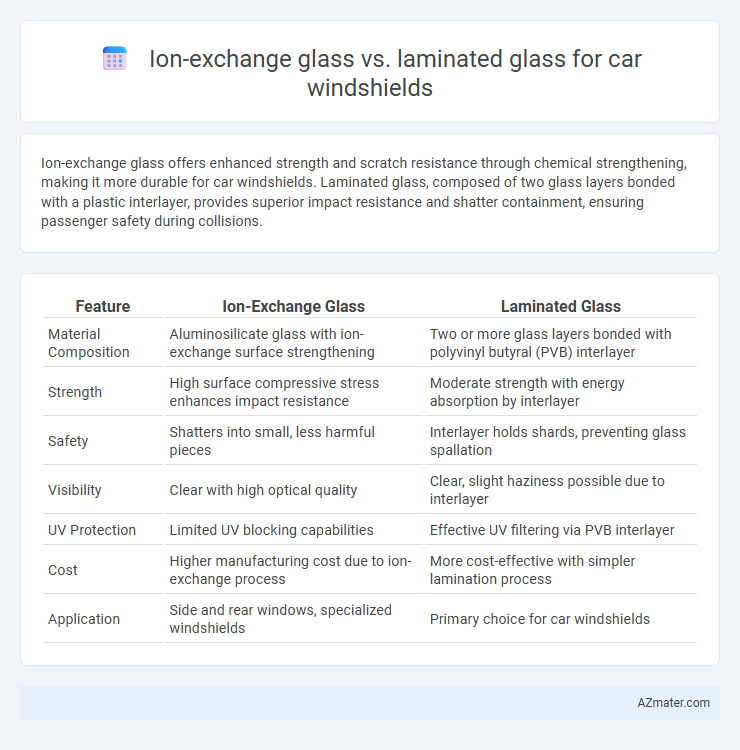Ion-exchange glass offers enhanced strength and scratch resistance through chemical strengthening, making it more durable for car windshields. Laminated glass, composed of two glass layers bonded with a plastic interlayer, provides superior impact resistance and shatter containment, ensuring passenger safety during collisions.
Table of Comparison
| Feature | Ion-Exchange Glass | Laminated Glass |
|---|---|---|
| Material Composition | Aluminosilicate glass with ion-exchange surface strengthening | Two or more glass layers bonded with polyvinyl butyral (PVB) interlayer |
| Strength | High surface compressive stress enhances impact resistance | Moderate strength with energy absorption by interlayer |
| Safety | Shatters into small, less harmful pieces | Interlayer holds shards, preventing glass spallation |
| Visibility | Clear with high optical quality | Clear, slight haziness possible due to interlayer |
| UV Protection | Limited UV blocking capabilities | Effective UV filtering via PVB interlayer |
| Cost | Higher manufacturing cost due to ion-exchange process | More cost-effective with simpler lamination process |
| Application | Side and rear windows, specialized windshields | Primary choice for car windshields |
Introduction to Modern Car Windshields
Modern car windshields primarily utilize ion-exchange glass and laminated glass, each offering distinct safety and durability features. Ion-exchange glass undergoes a chemical strengthening process that enhances impact resistance and scratch durability, ideal for automotive applications requiring high structural integrity. Laminated glass consists of two glass layers bonded with a plastic interlayer, providing superior shatter resistance and protecting occupants by preventing glass shards during collisions.
What is Ion-Exchange Glass?
Ion-exchange glass is a type of strengthened glass that undergoes a chemical process replacing smaller sodium ions with larger potassium ions on its surface, creating compressive stress that enhances its strength and scratch resistance. This glass technology improves durability and impact resistance, making it suitable for automotive applications requiring high safety standards. Compared to laminated glass, ion-exchange glass offers superior scratch resistance but lacks the shatterproof properties essential for windshields, which typically rely on laminated glass for impact containment and occupant protection.
What is Laminated Glass?
Laminated glass for car windshields consists of two or more glass layers bonded together with an interlayer, typically made of polyvinyl butyral (PVB) or ethylene vinyl acetate (EVA), which enhances safety by holding the glass fragments in place upon impact. Unlike ion-exchange glass, laminated glass provides superior shatter resistance and sound insulation, preventing injuries during collisions and reducing road noise. This type of glass is the industry standard for automotive windshields due to its durability, UV protection, and ability to maintain transparency after damage.
Comparative Strength and Durability
Ion-exchange glass exhibits superior strength due to a chemical strengthening process that compresses the surface, enhancing resistance to scratches and impacts compared to laminated glass. Laminated glass, composed of two glass layers bonded with an interlayer, offers enhanced durability by preventing shattering and maintaining structural integrity after impact. While laminated glass excels in safety by holding fragments together during collisions, ion-exchange glass provides greater overall toughness and longevity under everyday wear.
Safety Performance in Accidents
Ion-exchange glass offers enhanced surface strength and scratch resistance, reducing the likelihood of windshield shattering upon impact. Laminated glass incorporates a plastic interlayer that holds glass fragments together during collisions, significantly improving occupant safety by preventing glass shards from causing injuries. While ion-exchange glass enhances durability, laminated glass remains superior in maintaining windshield integrity and protecting passengers during car accidents.
Impact Resistance and Shatter Behavior
Ion-exchange glass offers enhanced impact resistance due to its chemically strengthened surface, which helps to prevent cracks and chips during collisions. Laminated glass features a polyvinyl butyral (PVB) interlayer that maintains structural integrity upon impact, reducing the risk of shattering and minimizing injury from glass shards. While ion-exchange glass provides superior scratch resistance, laminated glass excels in shatter behavior by holding broken glass pieces together for improved safety.
UV and Acoustic Protection Capabilities
Ion-exchange glass for car windshields enhances UV protection by incorporating a chemically strengthened surface that reduces ultraviolet radiation transmission, thereby minimizing interior fading and skin damage. Laminated glass, composed of two or more glass layers bonded with an interlayer, excels in acoustic protection by significantly dampening external noise and vibrations, providing a quieter cabin environment. While ion-exchange glass primarily improves surface durability and UV resistance, laminated glass offers superior sound insulation and impact resistance, making it a more effective choice for acoustic comfort.
Manufacturing Process Differences
Ion-exchange glass undergoes a chemical strengthening process where sodium ions in the glass surface are replaced with larger potassium ions, creating a compressive stress layer for enhanced durability and scratch resistance. Laminated glass is produced by sandwiching a polyvinyl butyral (PVB) interlayer between two glass sheets, which are then heated and pressed together, providing impact resistance and preventing shattering. The ion-exchange method focuses on modifying the molecular structure to improve strength, whereas laminated glass manufacturing emphasizes mechanical bonding for safety and structural integrity.
Cost and Availability Considerations
Ion-exchange glass for car windshields typically incurs higher manufacturing costs due to its specialized strengthening process, which limits its widespread availability compared to laminated glass. Laminated glass remains more cost-effective and readily accessible, benefiting from established production methods and extensive supplier networks. Cost-sensitive markets often prefer laminated glass as the standard windshield material because of its balance between affordability and sufficient safety performance.
Future Trends in Automotive Windshield Technology
Ion-exchange glass offers enhanced surface strength and scratch resistance, making it a promising material for future automotive windshields aimed at durability and safety. Laminated glass, incorporating multiple layers with interlayers like PVB or ionoplast, provides superior impact resistance and UV protection, which is driving its continued dominance in windshield technology. Future trends focus on integrating smart technologies such as heads-up displays and solar control films into both ion-exchange and laminated glass to enhance driver experience and vehicle energy efficiency.

Infographic: Ion-exchange glass vs Laminated glass for Car windshield
 azmater.com
azmater.com